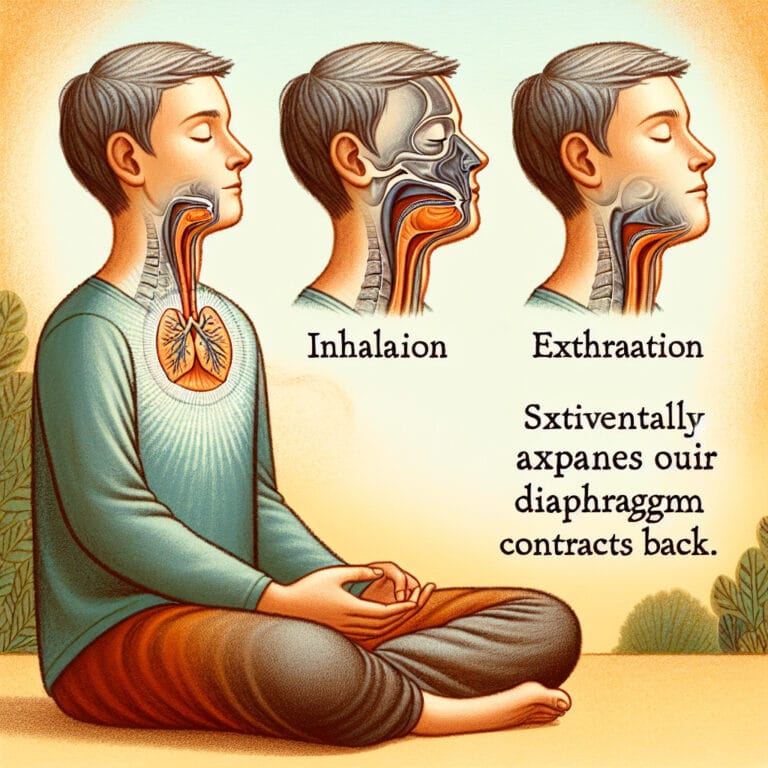
Unlocking Wellness: The Benefits of Diaphragmatic Breathing for Health
Table of Contents
- Introduction: The Importance of Breathing for Health
- Understanding Diaphragmatic Breathing
- The Benefits of Diaphragmatic Breathing
- How to Practice Diaphragmatic Breathing
- Conclusion: Integrating Diaphragmatic Breathing into Daily Life
- Frequently Asked Questions
Introduction: The Importance of Breathing for Health
Numerous studies have shown the impressive benefits of diaphragmatic breathing, a simple yet potent exercise that can significantly boost our health. The human body relies heavily on efficient oxygen supply for its optimal functioning, and this is where practicing diaphragmatic breathing plays a crucial role. Unlike superficial chest breathing which barely uses half of our lungs’ capacity, diaphragmatic or abdominal breathing involves deep inhalation through the nose, allowing more air to reach the lower part of your lungs by making your diaphragm move efficiently.
Notably, when you breathe using your diaphragm correctly, not only does it enhance respiratory function but it also triggers a relaxation response in your body by increasing heart rate variability – a sign of good autonomic nervous system balance between stress and relaxation. During this process of deep inhalation and exhalation, your rib cage expands while your stomach moves outward as the diaphragm contracts, providing an ample amount of oxygen to every cell in your body.
Moreover, proper use of diaphragmatic breathing helps regulate cortisol levels thereby reducing stress and anxiety—in fact it’s recommended as beneficial for those with conditions like generalized anxiety disorder. Furthermore, engaging in regular exercises such as lying flat on a surface with knees bent can train you to practice abdominal muscles effectively during respiration—which eventually leads to improved lung function and lowered blood pressure.
Beyond these physiological aspects though, lies another profound benefit: mental clarity. When we engage in aerobic exercise like pursed-lip or box-breathing techniques—forms of controlled deep breathing—it increases our brain’s ability to focus and concentrate. So whether you’re trying to improve physical performance or just looking for effective relaxation techniques to combat daily stressors—incorporating these exercises into routine could make significant improvements.
Lastly but importantly—not all forms are suitable for everyone. Therefore one should first learn how they typically breathe—is it shallow chest breather or deep belly one? Do their shoulders head upwards when they inhale or does the stomach move out? Understanding these basics can help tailor a breathing practice that reaps maximum benefits.
To sum up, diaphragmatic breathing represents a powerhouse of healing potential. It is more than just an exercise—it’s a lifestyle change that can boost overall well-being, from managing heart rate to supporting mental health. All it takes is some time, patience and dedication to master this simple yet powerful technique.
Understanding Diaphragmatic Breathing
Delving further into the marvels of diaphragmatic breathing, this practice manifests an array of health benefits. Predominantly, it significantly optimizes respiratory function by effectively utilizing your diaphragm and abdominal muscles to fill your lungs completely, leading to efficient oxygen uptake. When you practice diaphragmatic breathing, your rib cage expands and stomach moves outward as the diaphragm contracts— a rhythmic dance that allows for full capacity of air intake.
Interestingly, maintaining this deep breathing exercise requires you to relax certain muscle groups like your shoulders head while consciously pushing breathe down towards your lower back. As a result, not only does it improve lung function but also leads to better posture due to effective use of core muscles. Surprisingly simple and subtle shifts can have far-reaching impacts on how our bodies function.
Additionally, practicing diaphragmatic breathing is therapeutic in nature—particularly in managing stress anxiety. By focusing on nose-breathing techniques such as box-breathing or pursed lips method—a form of controlled deep breathing—it helps us tap into our body’s ability to self-regulate cortisol levels. This powerful connection between breath and hormonal balance is why researchers recommend it for conditions like generalized anxiety disorder.
However, there’s more than just physical wellness tied with this potent breathing practice; there are cognitive benefits too. Sustaining aerobic exercise through structured deep breathing exercises stimulates increased heart rate variability—an indicator of stress resilience—and promotes mental clarity by augmenting concentration abilities within our brain. It’s like providing a natural reset button that helps clear out mental fog and sharpens focus.
Moreover, consistent engagement with abdominal or diaphragmatic breathing exercises strengthens the autonomic nervous system—the system that controls numerous bodily functions including heart rate—contributing towards overall cardiovascular well-being. The immense power held within the simple act of regulated breathwork is strikingly evident when considering its potential influence over blood pressure regulation.
It takes persistence and dedication though; laying flat on a surface, knees bent, focusing on ensuring the chest remains still while letting the stomach muscles do the work. But with regular practice, we can train ourselves to breathe correctly by default—facilitating our lungs to work at their optimum with every breath we take.
So consider this: Every time you engage in diaphragmatic breathing technique, it’s more than just an exercise—it’s a commitment towards enhancing your health at multiple levels. A powerful tool that rests within us all, waiting for conscious activation. Dive into this reservoir of benefits and experience what optimal human body function feels like; after all, slow and deep always wins the race when it comes to breathing right!
The Benefits of Diaphragmatic Breathing
Harnessing the power of diaphragmatic breathing can lead to a multitude of both physical and mental health benefits, offering a simple yet effective means of enhancing overall well-being. One core advantage that sets this form of deep breathing apart is its remarkable ability to reduce stress levels. As we consciously engage our diaphragm, pushing breathe down towards the lower back, our bodies respond by moderating cortisol levels – the ‘stress hormone’. This physiological change not only curbs unhealthy spikes in anxiety but also promotes a sense of calm and relaxation.
Physical wellness is another key area that reaps significant rewards from regular practice of diaphragmatic breathing exercises. When done correctly—with the chest remaining still while encouraging movement in the stomach—this technique allows for full capacity filling of our lungs. The abdominal muscles work in harmony with your rib cage as air flows deeper into your lungs during each breath, enhancing respiratory function and lung capacity over time. Simultaneously, an increased focus on nose-breathing techniques like box-breathing or pursed-lip method fosters healthier heart rate variability—a signifier for cardiovascular fitness—and contributes towards regulated blood pressure.
But wait – there’s more! Not only does practicing diaphragmatic breathing bolster physical health; it also offers powerful mental health benefits too. Engaging in these forms of deep breathing exercise has been shown to significantly alleviate symptoms linked with conditions such as generalized anxiety disorder due largely to its calming effect on both mind and body. Furthermore, this mindful act of focused inhalation and exhalation serves as an effective tool for promoting mental clarity—helping clear out cognitive fog while sharpening concentration abilities.
A particularly interesting aspect lies within its potential influence on exercise capacity too—the autonomic nervous system controlling numerous bodily functions including heart rate gets strengthened through consistent engagement with abdominal or diaphragmatic breathing exercises. So whether you’re eager to boost your aerobic exercise performance or simply wish to unwind after a hectic day using relaxation techniques—incorporating diaphragmatic breathing into your routine can prove highly beneficial.
To sum it all up, the benefits of diaphragmatic breathing extend beyond just improved lung function. From fostering mental well-being to enhancing physical health and exercise capacity—the potential positive impacts are widespread. So next time you find yourself on a flat surface, consider bending those knees, focus on your diaphragm moving with each breath and dive deep into this powerful practice for holistic health betterment.
| Benefits | Description |
|---|---|
| Stress Reduction | By engaging our diaphragm and pushing breath down towards the lower back, our bodies respond by moderating cortisol levels, reducing stress and promoting a sense of calm and relaxation. |
| Physical Wellness | Regular practice of diaphragmatic breathing exercises enhances respiratory function and lung capacity. This technique also fosters healthier heart rate variability and contributes towards regulated blood pressure. |
| Mental Health Benefits | Practicing diaphragmatic breathing can significantly alleviate symptoms linked with conditions such as generalized anxiety disorder due to its calming effect on both mind and body. It also promotes mental clarity and concentration abilities. |
| Exercise Capacity | Diaphragmatic breathing exercises can strengthen the autonomic nervous system, which controls numerous bodily functions including heart rate. This can boost aerobic exercise performance. |
| Overall Health Betterment | Benefits of diaphragmatic breathing extend beyond just improved lung function. It fosters mental well-being, enhances physical health and exercise capacity, offering a holistic health betterment. |
How to Practice Diaphragmatic Breathing
By tapping into the power of our natural physiological patterns, diaphragmatic breathing offers an accessible tool for enhancing overall wellness. This vital technique begins by positioning oneself on a flat surface, ideally with knees bent and shoulders relaxed. The key here is to cultivate a level of relaxation that encourages deep breathing without straining the body or mind. As you settle into your position, begin focusing on abdominal breathing – this refers to intentionally involving the movement of your stomach as you breathe in and out deeply.
Now let’s delve into a step-by-step guide on mastering this invaluable technique. To start off, rest your hands gently on your stomach so you can feel it rise and fall as you breathe. Once comfortable in this posture, take time to notice how your chest remains still while the focus shifts towards ensuring that it’s your stomach moving with each breath cycle – this is at the heart of practicing diaphragmatic breathing correctly.
Once familiarized with abdominal movements during respiration, try incorporating nose-breathing techniques such as pursed lips or box-breathing exercises to further enhance lung function. Pursed-lip breathing involves inhaling through the nose for two counts and then exhaling slowly through pursed lips for four counts; whereas box-breathing consists of slow inhalations for four counts followed by holding breath for another four counts before releasing it gradually over four more counts – forming a virtual ‘box’ pattern.
These exercises encourage complete filling of lungs during each breath cycle assisting in dilation of airways thereby maximizing oxygen absorption—a factor fundamental to effective respiratory function. Moreover, consistent practice helps strengthen diaphragm muscles leading to better control over one’s breaths—resulting in lowered blood pressure levels along with improved heart rate variability—an indicator signifying balance between stress-relaxation responses within our autonomic nervous system.
However, remember that just like any new skill being learned—patience and persistence are critical components when integrating these practices into daily routine—as regular engagement helps the human body to readjust its breathing patterns over time. So, while it might initially seem challenging to keep your chest still, or pushing breathe down towards your lower back as diaphragm contracts—the act of repeatedly practicing these exercises will gradually train your abdominal muscles to take the lead during respiration.
To sum up this practice guide for beginners looking to explore diaphragmatic breathing benefits: start off by finding a flat surface, bend those knees and relax those shoulders—then focus on moving that stomach in rhythm with each breath while keeping that chest still. Explore nose-breathing techniques like pursed-lip method or box-breathing exercises—and remember patience is key here—allowing one’s body plenty of time and consistent practice sessions to assimilate this new way of deep breathing into its natural rhythm. After all, it’s not about how quickly we master this skill—it’s about creating a long-lasting connection between our breaths and overall health—a commitment well worth making!
Conclusion: Integrating Diaphragmatic Breathing into Daily Life
As surprising as it may sound, the simple act of diaphragmatic breathing can be a transformative tool for holistic health betterment. When incorporated into daily routines, this deep breathing exercise can play a pivotal role in regulating our body’s critical functions. Imagine, by laying on a flat surface with knees bent and focusing on how your stomach moves in rhythm with each breath—you’re not only enhancing respiratory function but also exercising control over heart rate variability—an indicator of balance between stress and relaxation within our autonomic nervous system. The beauty lies in pushing breathe down towards the lower back: as the diaphragm contracts, lungs fill up completely ensuring efficient oxygen supply—a factor fundamental to effective aerobic exercise performance. Moreover, consistent practice helps moderate cortisol levels—our body’s stress hormone—providing relief from conditions like generalized anxiety disorder and boosting overall mental clarity. One could say that each breath taken correctly is one step closer to improved health and well-being—the essence of abdominal or diaphragmatic breathing technique. So next time you find yourself seeking effective relaxation techniques—consider engaging those stomach muscles during respiration—it’s more than just an exercise; it’s nurturing your human body’s ability to function optimally—one deep breath at a time!



